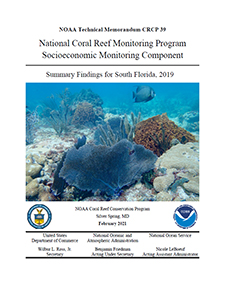-
Home
-
Data & Publications
-
Regional Portals
- About Regional Portals
- Florida
- Navassa Island
- Puerto Rico
- Flower Garden Banks
- U.S. Virgin Islands
- American Samoa
- Commonwealth of the Northern Mariana Islands
- Federated States of Micronesia
- Guam
- Main Hawaiian Islands
- Republic of the Marshall Islands
- Northwestern Hawaiian Islands
- Republic of Palau
- Pacific Remote Island Areas
-
CRCP Activities
- Glossary
National Coral Reef Monitoring Program Socioeconomic Monitoring Component. Summary Findings for South Florida, 2019

The Socioeconomic Component of the National Coral Reef Monitoring Program (NCRMP) gathers and monitors a collection of socioeconomic data in seven U.S. coral jurisdictions. The team started its second monitoring cycle with data collection in South Florida in 2019, and recently released their report of summary findings along with a new infographic. The report outlines current human dimensions information relevant to coral reef resources in South Florida, as well as trends between the first (2014) and second monitoring cycles, while the infographic focuses solely on the 2019 findings. Survey results are representative of each of the five counties adjacent to Florida’s coral reef tract: Martin, Palm Beach, Broward, Miami-Dade, and Monroe.
Household surveys conducted in April to August of 2019 revealed that South Florida residents generally supported a range of potential marine management policies and regulations (such as efforts to restore damaged coral reefs, stricter control of sources of pollution to preserve water quality, and increased public education on sea level rise and climate change), and felt that coral reefs were important to South Florida’s culture and tourism. Surveys also revealed that South Floridians’ top three activities continued to be beach recreation, swimming, and boating, along with significant increases in resident participation in fishing, snorkeling, island/sandbar recreation, and watersports compared to the 2014 survey. Additionally, awareness of threats to coral reef ecosystems tended to be low among residents of Martin, Miami-Dade, Palm Beach, and Broward Counties, while Monroe County residents were not only more aware of threats, but also more familiar with marine protected areas (MPAs). When examining perceptions of marine resource conditions, residents in 2019 were more likely to be sure about their perceptions than residents were in 2014, but their general outlook was that resource conditions, especially coral amount and ocean water quality, had become worse.
These and other findings offer early glimpses into NCRMP socioeconomic monitoring of South Florida’s coral reefs, and they will be used to update composite indicators that detail the status of South Florida’s coral reef adjacent communities in relation to the other U.S. coral reef jurisdictions. As each monitoring cycle takes between five and seven years to complete, South Florida residents are targeted for surveying again in 2026.
Citation: M.E. Allen, C.S. Fleming, B.M. Zito, S.B. Gonyo, S.D. Regan, and E.K. Towle 2021. National Coral Reef Monitoring Program Socioeconomic Monitoring Component: Summary Findings for South Florida, 2019. US Dep. Commerce, NOAA Tech. Memo., NOAA-TM-NOS-CRCP-39, 60p. + Appendices. doi:10.25923/w6pa-hv50
Download Products
- Summary Findings for South Florida, 2019 - Full Report
- Takeaways from the South Florida 2019 Survey - Infographic
Related project information
- National Coral Reef Monitoring Program: Understanding Socioeconomic Connections
- National Coral Reef Monitoring Program: South Florida Infographics
- Summary Findings for South Florida, 2014


